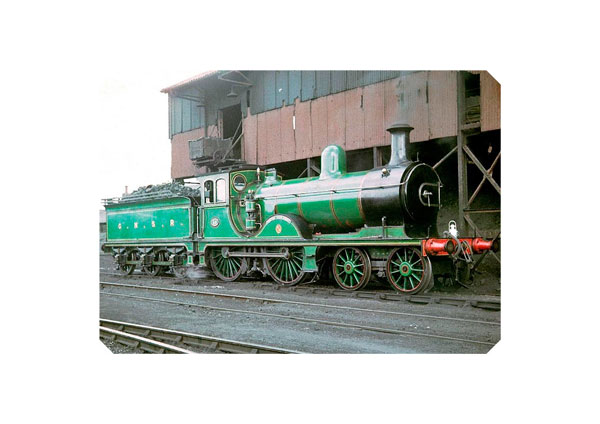Description
The first locomotive superintendent, 1853 – 1855, was the brilliant but erratic Daniel Kinear Clark 1822 – 1896. He must be regarded as more of a consultant than a “hands on” loco supt.,as he apparently refused to work at Aberdeen, and was even reluctant to visit Manchester to inspect locomotives which he had ordered from Fairbairn.
John Folds Ruthven replaced Clark in 1855, but only ordered two locomotives; he was in turn succeeded by William Cowan (1823 – 1898), (on the miserable salary of £160 p.a.)in 1857. Cowan had come to the GNOS from the Great Northern Railway of England, to manage the Scottish company’s small locomotive works at Kittybrewster. He participated in the efforts to restore the company’s fortune, but was sometimes at odds with the directors, and resigned in 1883 to become the sales representative for Krupp’s steel railway products in Britain.
His successor was James Manson (1845 – 1935) born at Saltcoats, the son of a Glasgow & South Western Railway District Superintendent, he entered that company’s works at Kilmarnock at the age of 15, under the Locomotive Superintendent Patrick Stirling, and his brother James Stirling, who was Works Manager. By 1869, Manson was in the Drawing Office, but left to work for marine engineers, Barclay, Curle & Co., Glasgow. The following year, he signed on with the Bibby Line, as third engineer on one of their steamers plying between the Mersey and the Mediterranean, soon being promoted to chief engineer. James Stirling had succeeded his brother, when the former went to the GNR England, and James enticed Manson back to the G&SWR as his outdoor assistant, rising to Works Manager in1878. Manson was experienced and well qualified when he came to the GNOS as Locomotive Superintendent, in 1883,
He needed to be. Hamilton Ellis wrote “Truly the Great North in mid Victorian times was a fair match for England’s Lancashire & Yorkshire Railway, which Ahrons described as being the most degenerate railway in the kingdom. If the L&Y were casual and doddering, the Great North, was apparently, vilely bad out of sheer mischief.” Passengers and freight customers were treated with contempt, the former often being left stranded, with no indication of when the journey might be completed, the second suffering unexplained delays and losses of their consignments, while it seemed to be a matter of policy that under no circumstances would a GNOS train make a connection with those of any other company. All this began to change, with the appointment of a vigorous new General Manager, William Moffatt, a North Eastern Railway district officer from Tyneside,in 1880. By the end of the century, the GNOS was a model of what a railway should be “there hardly seemed room for improvement.” wrote the Rev. W. J. Scott in 1898.
James Manson played a significant part in this transformation, before returning to the G&SWR as Locomotive Superintendent in 1891. His successor at the GNOS was James Johnson, a son of Samuel Waite Johnson, the Midland Railway Locomotive Superintendent, trained by his father at Derby. James Johnson stayed for only a couple of years, leaving the railway industry to manage a general engineering works.
His replacement was William Pickersgill, (1861-1928) who, although born at Crewe, served an apprenticeship at the Stratford Locomotive Works of the Great Eastern Railway, under William Adams, where a near contemporary was W. F, Pettigrew, later to become Locom9otive Superintendent of the Furness Railway. Pickersgill rose to become DivisionalLocomotive Superintendent Norwich in1891, taking over from Johnson on the GNOS in 1893. He brought with himthe American deign of side window cab, which T. W. Worsdell had introduced on the GER after working in the USA at Altoona. Pickersgill oversaw the building of a new locomotive works at Iverurie (next to Eastleigh, the most modern in Britain) before leaving to become Chief Mechanical Engineer of the Caledonian Railway, in March 1914.
The GNOS last Locomotive Superintendent also came from “south of the border” – in this case, from Wales. Appointed in 1914, he was Thomas Edward Hett Heywood (1877 – 1953), born in Cardiff, he was trained as a pupil of Tom Hurry Riches on the Taff Vale Railway. After serving as an Inspector, he left for Burma in 1902, where he became Assistant Loco. Carriage & Wagon Supt, but returned to take various management posts on the Taff Vale. Taking office with the GNOS only weeks before the Great War began, He was one of a handful of younger locomotive engineers, (eg Chalmers of the North British and Beames of the LNWR) whose potential was never fully realised because of the War, and because they lacked age and seniority when the much reduced number of top jobs were filled after the Amalgamation of 1923 . from being head of the loco department, with a small but modern works under his command, Heywood had to be content with the post of Locomotive running Superintendent for the Northern Scottish Area of the London & North Eastern Railway.
Although superseded by longer and more detailed works, this booklet remains a useful compact reference source for Great North of Scotland Railway locomotives.
PREVIEW BELOW – MAY TAKE A WHILE TO LOAD.

Reviews
There are no reviews yet.